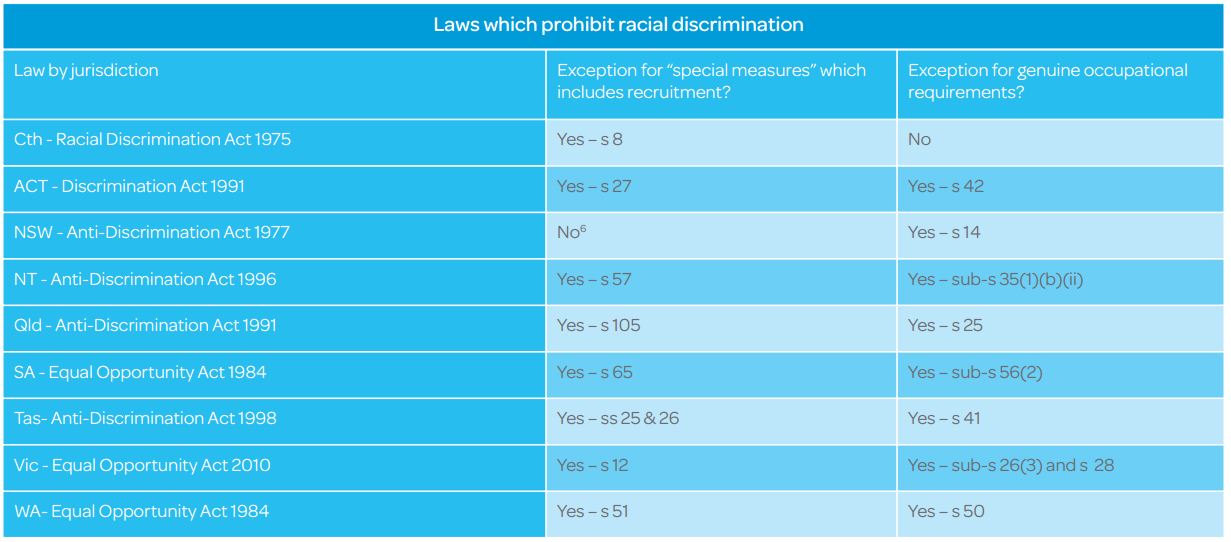Exceptions for genuine occupational requirements
Each state and territory discrimination law contains one or more provisions which apply to allow discrimination in recruitment if being of a particular race is a genuine occupational requirement for a particular job. An employer wishing to recruit an Aboriginal or Torres Strait Islander person for a role may be able to rely on one of these exceptions if being Aboriginal or Torres Strait Islander is connected to the ability to perform that role. For example, if the role involves liaising with Aboriginal and/or Torres Strait Islander communities, a genuine occupational requirement provision may apply.
The wording and scope of the genuine occupational requirements exceptions vary across the different jurisdictions. For example, subs 25(1) of the Anti-Discrimination Act 1991 (Qld) is drafted in very broad terms, providing that "[a] person may impose genuine occupational requirements for a position". By contrast, in NSW the exception in s 14 of the Anti-Discrimination Act 1977 specifies the types of roles that will be covered:
14 Exception-genuine occupational qualification
Nothing in this Division applies to or in respect of any work or employment where that work or employment involves any one or more of the following:
(a) participation in a dramatic performance or other entertainment in a capacity for which a person of a particular race is required for reasons of authenticity,
(b) participation as an artist's or photographic model in the production of a work of art, visual image or sequence of visual images for which a person of a particular race is required for reasons of authenticity,
(c) working in a place where food or drink is, for payment or not, provided to and consumed by persons in circumstances in which a person of a particular race is required for reasons of authenticity, or
(d) providing persons of a particular race with services for the purpose of promoting their welfare where those services can most effectively be provided by a person of the same race.
Employers will accordingly need to check the wording of the particular genuine occupational requirements exception available in the jurisdiction/s in which it operates to see if the jobs they intend to advertise would fall within that exception.
Note however that the RDA does not include an exception for genuine occupational requirements. Therefore even if being Aboriginal or Torres Strait Islander is a genuine occupational requirement for a position, targeted recruitment for that position must also meet the criteria for a special measure in order to be consistent with the federal law.
Exceptions for special measures
Based on my experience, special measure provisions are perhaps the aspect of Australian discrimination law that are the least well known or understood.
Discrimination laws protect the right to equality and non-discrimination. However, these laws recognise that promoting the right to equality does not always mean identical treatment among different groups. As the Victorian Civil and Administrative Tribunal has recognised, "access to opportunity may not be available to all … unequal results can arise from equal treatment and so steps may need to be taken to create true [substantive] equality".vi In certain circumstances, it is necessary to take positive action to address the entrenched disadvantage suffered by a certain section of the population, in order that they may have similar access to opportunities as others in the community.
All Australian discrimination laws which prohibit racial discrimination except the Anti-Discrimination Act 1977 (NSW) include provisions which render positive actions taken to ameliorate the disadvantage experienced by a particular racial group lawful, provided certain legislative requirements are met.
These positive actions are referred to as:
- "special measures" in the RDA, the Northern Territory and Victorian laws;vii
- "measures intended to achieve equality" in the ACT and Western Australian laws;viii
- "projects for benefit of persons of a particular race" in the South Australian law;ix
- "equal opportunity measures" in the Queensland law;ix and
- either "schemes for the benefit of disadvantaged groups" or a "program, plan or arrangement designed to promote equal opportunity" in the Tasmanian law.xi
For the purposes of this article, the term "special measures" is used generically to refer to these types of positive actions.
A program which targets Aboriginal and Torres Strait Islander people for employment opportunities to redress their under-representation in a workplace is an example of a special measure. Such a program might include:
- reserving certain positions for Aboriginal and Torres Strait Islander applicants;
- guaranteed interview schemes;
- work placements, traineeships or mentoring programs; and
- engaging an Indigenous Recruitment Service to hire trainees, graduates and fill other roles.
Provided a targeted recruitment program meets the requirements of a special measure, it is lawful under discrimination law (other than in New South Wales, where an employer is required to seek an exemption).
Five requirements for targeted recruitment to be a special measure
The core elements of a special measure are essentially the same under the RDA and state and territory discrimination laws. The following test consolidates the various requirements under these laws in the different jurisdictions. To meet the test for a special measure in all jurisdictions, an employer must be able to show that a targeted recruitment strategy:
- is necessary because members of a racial group are disadvantaged because of their race;
- will promote equal opportunity for members of that racial group;
- has the sole purpose of promoting equal opportunity (and will be done in good faith);
- is reasonable and proportionate (including reasonably likely, appropriate and adapted to achieve its purpose); and
- will stop once its purpose has been achieved.
A case which illustrates how many of these requirements can be met is the Victorian Civil and Administrative Tribunal decision below.
The Ian Potter Museum of Art (Anti-Discrimination Exemption)xii
Facts
The applicant museum (part of the University of Melbourne (the University)) applied for an exemption under s 89 of the Equal Opportunity Act 2010 (Vic) (the EO Act) to be able to advertise for and employ an Indigenous person in the role of "Vizard Foundation Assistant Curator". In support of its application, the applicant submitted a copy of the University's Indigenous Employment Framework 2010-2013. This document recognised the disadvantage suffered by Indigenous Australians, included reference to relevant statistics from the Australian Bureau of Statistics and the (low) number of Indigenous staff at the University, and stated the University's commitment to increase its number of Indigenous employees.
The applicant also led evidence that as at June 2009, the University employed approximately 7,270 people, only 30 of whom were Indigenous. The applicant itself had one Indigenous employee out of a staff of 15.
The applicant stated that it sought to redress the imbalance in terms of the representation of Indigenous Australians within the University (and within the Australian art museum profession as a whole) by appointing only an Indigenous person to the position.
VCAT decision
The Tribunal assessed the applicant's proposed targeted recruitment measure against the requirements for a special measure under s 12 of the EO Act (these requirements are subsumed within the 5 requirements mentioned above).
In terms of the requirement in the EO Act that the measure be justified because there is a particular need for advancement or assistance (e, requirement 1 above, was it necessary because members of a racial group were disadvantaged because of their race), the Tribunal held that:xiii
The ABS information … makes clear that Indigenous Australians as a group suffer many forms of disadvantage. Of most relevance here are the lower rates of employment, lower income levels, matters relating to health which impact on a person's overall wellbeing and the rates of discrimination … that material establishes the need for advancement and assistance so that Indigenous people have greater opportunities for employment and that an appropriate way to achieve that end is, from time to time, to reserve positions for Indigenous applicants only.
In relation to the requirements in the EO Act that the purpose of the measure be to promote substantive equality for members of that racial group, and that it be undertaken in good faith (covered by requirements 2 and 3 above), the Tribunal found that:
- the purpose of the measure was to provide an employment opportunity for an Indigenous person;
- a second purpose was to increase the employment levels of Indigenous Australians within the applicant and the University as a whole; and
- given the position of Vizard Foundation Assistant Curator was created to achieve these purposes, the proposed conduct was to be undertaken in good faith for those purposes.
Finally, considering whether the targeted recruitment was likely to achieve its purpose and was a proportionate means of achieving that purpose (requirement 4 above), the Tribunal held that it was likely to achieve its purpose as:xiv
On an Indigenous Australian being employed in this position, that individual will clearly benefit in the way intended. In addition, Indigenous Australians will benefit by another of their number being employed.
In relation to proportionality, the Tribunal stated that:xv
At present, out of a staff of 15, only one employee of the applicant is Indigenous. As at June 2009, across the University as a whole Indigenous employees represented less than 0.5% of the staff. That figure is dramatically less than the number required to represent the proportion of Indigenous people in the wider population. In these circumstances, the proposed conduct is a proportionate means of achieving the applicant's purposes.
The Tribunal therefore concluded that the "conduct bears upon its face the clear stamp of a special measure".xvi It accordingly made a declaration (under s 124 of the EO Act) that the proposed targeted recruitment was a special measure as permitted under s 12 of the Act.xvii As the applicant would therefore not discriminate against a person contrary to the EO Act by taking the measure, the Tribunal held that no exemption under s 89 was necessary, and struck out the applicant's application as misconceived.xviii
Applying for exemptions for conduct which meets the requirements of a special measure
As mentioned earlier, there is no relevant special measures provision under the Anti-Discrimination Act 1977 (NSW) (the NSW Act). It is therefore necessary for employers wanting to conduct targeted recruitment for Aboriginal and Torres Strait Islander people in New South Wales to apply for an exemption from that Act.
In all jurisdictions other than New South Wales, the granting of an exemption is not a legal prerequisite for conducting a targeted recruitment strategy, as long as the recruitment program meets the requirements of a special measure. The purpose of an exemption is to exclude the application of a particular law to certain conduct which would otherwise breach that law. However, an action that meets the requirements of a special measure will not be unlawful, because it already falls within a recognised exception to discrimination law.
Despite this, some employers may choose to apply for an exemption for a targeted recruitment strategy, and may be granted one in some jurisdictions, even though the proposed conduct meets the requirements of a special measure. However, when employers apply for exemptions to protect special measure conduct, they may not be successful. The granting of exemptions is discretionary, and the case law in some jurisdictions is inconsistent.
Generally, the bodies with the power to grant exemptions consider whether an applicant requires an exemption in order to avoid breaching discrimination law. If the conduct meets the requirements for a special measure which is permitted under the relevant law, these bodies may refuse to grant an exemption.xix
Finally, it must be recalled that there is no exemption process under the RDA. This means that even if an employer is granted an exemption under a state or territory discrimination law, its targeted recruitment program must still meet the criteria for a special measure, to comply with the RDA.
Conclusion
Employers wanting to promote the rights of Aboriginal and Torres Strait Islander people by conducting targeted recruitment programs should utilise the special measure provisions in the RDA and state and territory discrimination laws.
For more information about the special measure provisions, and how to design, document and implement a targeted recruitment strategy to meet the requirements of a special measure, see the resource recently published by the Commission: Targeted recruitment of Aboriginal and Torres Strait Islander people: A guideline for employers.
Note: This article was originally published in Employment Law, November 2015, Volume 21 No 10
- Australian Human Rights Commission Good practice good business factsheets available at www.humanrights.gov.au.
- Australian Human Rights Commission, Employers, available at www.humanrights.gov.au.
- Australian Human Rights Commission, Join the network, available at www.humanrights.gov.au.
- The RDA, ss 9 and 15.
- "Special measures" are not defined in the RDA, rather the definition is drawn from article 1(4) of the International Convention on the Elimination of All Forms of Racial Discrimination.
- The Ian Potter Museum of Art (Anti-Discrimination Exemption) [2011] VCAT 2236, at [32].
- The RDA, s 8(1); Anti-Discrimination Act 1996 (NT), s 57; Equal Opportunity Act 2010 (Vic), s 12 (see also Charter of Human Rights and Responsibilities Act 2006 (Vic), s 8(4)).
- Discrimination Act 1991 (ACT), s 27; Equal Opportunity Act 1984 (WA), s 51.
- Equal Opportunity Act 1984 (SA), s 65.
- Anti-Discrimination Act 1991 (Qld), s 105.
- Anti-Discrimination Act 1998 (Tas), ss 25 and 26.
- Above, n 7.
- Above, n 7, at [39].
- Above, n 7, at [35].
- Above, n 7, at [36].
- Above, n 7, at [52].
- Above, n 7, at [53].
- Above, n 7, at [52]-[53].
- See, for example, the decision in Downer EDI Mining [2013] QCATA 276.
 LexisNexis
LexisNexis



